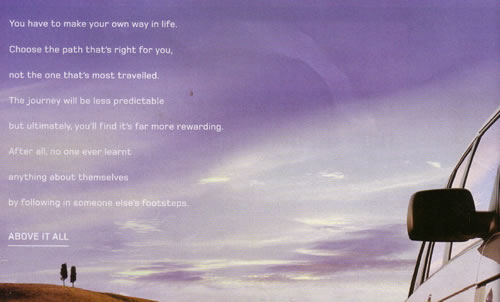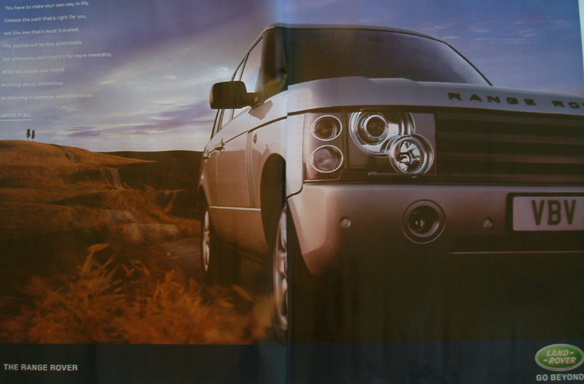Touting your trade has been a necessary part of human life since language began and probably before. People handing out leaflets with simple information about gigs or products is fine. I don’t see anything wrong with Google Ad-sense, because it’s discrete, purely informative and doesn’t try to trick you. It even tries to be relevant to what you actually need. This post is about ads which deliberately mislead people.
People think that adverts don’t affect them. Everyone I speak to says “Oh I don’t think I would buy something because of an advert.”. But most ads work subliminally. Like this one:

- Trick No. 1. Subconscious symbollism. Many adverts contain phallic symbols. Long thin things with some sort of fluid coming out of the top, long thin things going through holes. This page shows some really obvious examples. Check out the sprinkler between the woman’s legs in the Nokia ad. Perhaps the grass is a symbol of youth and growth? In the bag advert, there are the two round bags and then the book with the nobby thing on top and then the pot with brushy things coming out of it.
People say – well that’s not what I think of when I look at it – but that’s the whole point of it – they wouldn’t show pornographic pictures – they show seemingly innocent pictures which access your subconscious. Freud wrote about how dreams reveal the importance of symbolism in the human subconscious. Advertisers know all about it. It’s not just phallic imagery that gets used. Images of freedom are also common: like birds, sailing boats, skiing etc…
There are 2 examples of subconscious symbollism in this one from a popular British magazine – the hair and the 2 round oranges next to the big green column shaped shampoo bottle with the liquid right next to it.

Please send me more if you find them… - Another trick is to make you want something a lot and then show their product, so that you transpose your desire onto that product. It’s the same old trick over and over again. Something really desireable, but which you know you can’t have like a sexy woman or man (not many people have a supermodel girlfriend), or a young couple in love, humour, laughter, cosiness food, love, cute well behaved children – whatever the people they’re targeting most want.
Here are some particularly amusing examples of this particular one (they are Italian sock packets).

- Playing on your base fears or desires – fear and insecurity – insurance salesmen describing worst case scenarios – what if something goes wrong on holiday – what if your children die etc…
e.g. Adverts for houses play on the desire for a secure, stable environment (and a 200k mortgage??) - Play on a deep fear of missing out or being left out. Limited offer, only for the next week.
- Bombardment. A mere awareness of a name is enough to make you choose a product. You might not know anything particular about Ford but because you’ve heard of it, you’d rather buy one than a Vectron.
- Take over a respected source which appears to be unbiased – e.g. pay a tv program or a newspaper to review their product.
- Creating spurious associations in your mind – e.g. between cigarettes and sportiness by sponsoring sport.
- Blatant absurd lies – if you look at it for more than 2 seconds.
Here’s an example. “Currys – always cutting prices” (this is a real slogan). If that was true, then pretty soon they’d be giving things away free. Then after that, they’d be paying you to take things away. Things like “we only care about YOU” are blatant lies
. - Capitalising on curiosity. Presenting you with something that you have to think about a lot to understand. That way you spend 1 minute thinking about something associated with a product and it sticks in your mind.
- Perhaps the most ironic technique of them all. The “As individual as YOU are” technique. This is somewhat related to the “stand out from the crowd” technique (see below) as it plays on people’s desire to feel special. The basic technique is to emphasise the ego of the person being targeted – to play to people’s sense of self-importance. There are so many ads with YOU in capital letters, or emphasised in the voiceover “Made for YOU”, “Designed around YOU”, “As soft as YOUR skin” etc…. etc… (If I am the target customer, then who else would it be designed around???? If it means me individually then how do they know how individual I am.).
Advertising is often targetted at specific groups – here are some of the techniques I have noticed:

Comes from:

1. Teenagers/young people – “stand out from the crowd” – buy the same product as everyone else we’re hoping to persuade with this ad. Be an individual, flout convention, assert your freedom, be a rebel – ( and do what we want you to do along with as many other people as possible) .
Other teenager tricks are – no fear – buy a snowboard and you won’t be afraid any more. Be accepted by a group of good-looking peers.
2. People with families – security – happy children, familiar not too close to the bone jokes etc…
3. Young children – the worst as they are psychologically defenceless and yet very good at controlling parent purse-strings. I’m not sure what techniques they use – friendly cartoon types like Ronald McDonald and of course they put the sweets at the counter in the supermarket.
I have also noticed a lot of adverts talking about things which seem to be woefully lacking in most people I meet. “Live life to the full” “The excitement of the open road” – buy a 4WD and cruise around London at 4mph. “Pure emotion” – I heard this morning on the radio – I can’t remember but it was probably advertising a car or a shampoo or something. It seems that if you appeal to a person’s deepest feelings of inadequacy they won’t notice that what you are saying is utterly absurd.

Here are some more pictures in my collection:
